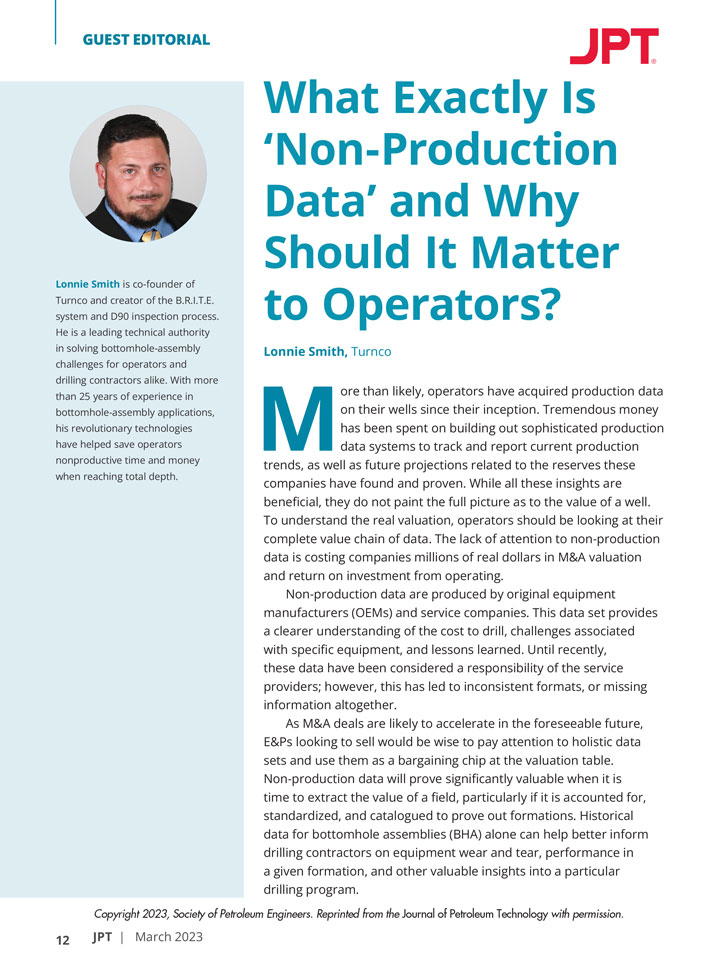What Exactly is ‘Non-Production Data’ and Why Should it Matter to Operators?
Introduction
More than likely, operators have acquired production data on its wells since their inception. Tremendous money has been spent on building out sophisticated production data systems to track and report current production trends, as well as future projections related to the reserves these companies have found and proven. While all of these insights are beneficial, it does not paint the full picture as to the value of a well. To understand the real valuation, operators should be looking at the complete value chain of data within its supply chain. The lack of attention to non-production data is costing companies millions of real dollars in M&A valuation and return on investment from operating.
Non-production data is produced by original equipment manufacturers (OEMs) and service companies. This data set provides a clearer understanding of the cost to drill, challenges associated with specific equipment and lessons learned. Until recently, this data has been considered a responsibility of the service providers; however, this has led to inconsistent formats, or missing information altogether.
As M&A deals accelerate for the foreseeable future, E&Ps looking to sell would be wise to pay attention to holistic data sets and use it as a bargaining chip at the valuation table. Non-production data will prove significantly valuable when it is time to extract the value of a field, particularly if it is accounted for, standardized and catalogued in order to prove out formations. Historical data for bottom-hole assembly alone can help better inform drilling contractors on equipment wear and tear; performance in a given formation; and other valuable insights into a particular drilling program.
The Complete Value Chain of Data
According to the Seeking Alpha, drilling can make up 40 percent of the total cost to bring a well online, with the average well cost in the Permian Basin ranging from approximately $5 million to $9.3 million as of 2017. This means drilling costs could be as high as $3.72 million per well – and these numbers are pre-COVID and pre-inflation.

Many of the onshore wells brought online today are not produced by the original E&Ps that discovered the assets, but instead by the latest buyer. When the purchase was made, significant diligence was done to ensure the production data was correct. Unfortunately, many details and lessons learned during the drilling process were not kept as part of that acquisition, so the new owners were left to potentially solve the same problems again. Those reinvestments can be further compounded by the costly current state of the industry.
The missing details and lessons learned referenced above include the terabytes of information from the multitude of service companies involved in originally bringing that well online. Data such as mud characteristics, BHA tool configurations, well plan deviations, casing and cementing solutions, as well as, mud weight, or size of the motor may be recorded in a software such as Well View. But what about the specific configuration data such as power section fit, stabilizer shape, hard banding material, or bit to bend length, just to reference a few? These data points are often adjusted and dialed-in over time in order to find just the right recipe for a specific area. Unfortunately, this information never makes it into the official logs or databases of the operating company.

Problems with the data
While there are some industry organization standards in the works, an established set of standards on what information needs to be kept and reported to the E&P does not exist. And until the industry collectively focuses on making this a priority issue, it will continue to struggle with the lack of consistency. Today, each individual operator is left to establish their own standards on what data is important, how it is stored, and where it needs to be stored. In a climate where the trend is for drilling engineers to manage more wells per engineer than ever before, this creates a tremendous number of challenges.
With exceptions such as bit grade, there have been very few data standardizations that would enable data consolidation from one service company to another. There is also limited technical knowledge within the E&P of how this data can be used in order to take advantage of the latest data science technology.
If a specific data plan is not defined by the operator each service company can capture different sets of information, create different labels for the same data, and use different techniques or methodologies to calculate the same information. Even if the information is provided in digital form, outputs of data could have its own set of challenges, including proprietary formats that are not compatible with other software analysis programs and/or are inefficiently stored, such as 300 hundred files in individual folders.
One solution to this problem is for the E&P to lean heavily on the individual service providers to maintain and supply this information. While this eliminates the need to pay for the resources of a dedicated team to manage the collection and standardization process, the risk remains very high that the data will be lacking or not available when the time to call on it arrives. Per information collected by Haynes & Boones law firm, in 2021, 36 oilfield service companies went out of business. And although bankruptcies the last two years have been fewer than normal (thanks to government programs instituted during the pandemic), when these companies do dissolve, so does the data.
Best Practices for Data Collection
While production data is significant for all E&P acquisitions, don’t overlook the opportunity to leverage noteworthy data sets outside of this specific category. Companies with the most forward-looking view on all data relevant to an investment will be best positioned to take advantage of the years of trial-and-error required to discover those assets. Otherwise, lessons will have to be learned again to realize their highest value.

Some best practices to consider when instituting a data collection program:
- Start by defining a data quality plan for your service providers. Everyone needs to be working from a single truth. Work with your internal data science team, or even look to consult with data science experts, to develop a specific set of standards for services data. Think in terms of actual measurable details that can be applied to vendors broadly, such as the measurement or tolerance for a component, not proprietary things such as brand names.
- Define what methodology and important calculations you should use such as mechanical specific energy (MSE); many of these can be calculated several different ways, and you want to ensure you are comparing apples to apples.
- Work with your legal teams to craft a by-line in your MSA, ensuring you have lasting rights to any data that is not proprietary. Many of the clients I work with have done a great job of protecting data from being shared with others, but do not have anything related to ongoing access to data years after the project, nor have they clearly defined ownership of data that is generated as a secondary or tertiary by-product of the drilling process.
- Don’t just consider the vendor that you interact with directly, but consider your suppliers’ vendors. Product successes could be a bi-product of a deeper layers of the supply chain.
- If you have a large number of service providers consider working with an independent software company that will coordinate with your individual suppliers and consolidate this information for you. These companies may add cost but the savings you will gain from having this information will be worth it. Additionally, these companies will already have ongoing established pipelines with many of the most common suppliers so the program will get up and running much faster.
- Finally, look to your IT department to develop an effective way to database and store this data so it can be easily accessed for data entry by your service companies and your data science teams for analytics and machine learning processes in the future. The best implementations are cloud-based solutions accessed via web. This allows geography or company network infrastructure to not be a limiting factor.
Conclusion
Whether buying or selling, quality, non-production data can help operators achieve improved margins and less downtime, unlocking the true potential of its wells.
For operators looking to buy, the degree of non-production data quality specific to the external drilling service company process can pay huge dividends when a company is ready to drill additional wells. This is the case even if drilling does not begin for years into the future. With a little bit of planning and attention, you can be assured the most significant details will be available for your future analysis. Additionally, if the final owners of the field have a data team, access to this catalogued data may lead to new insights in the drilling process as operators and drilling contractors continue to drill even more efficiently and economically than the previous owners.




